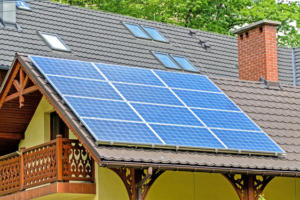This post was written by Ben Hastings ’18
Arguably, California is the country’s leader in climate action, with an ambitious goal of deriving 50 percent of the state’s energy from renewable sources by 2030. The state is on its way to achieving 33 percent by 2020 and just made a huge step toward making its goal a reality.
 In 2 years, all new homes built in the state will be mandated to either have solar panels installed or be hooked up to shared solar panels that power a grouping of the new homes. New home buyers will have the option to purchase the panels outright where they are included in the price of the home or can be leased. The increasing amount of solar energy to be included in the energy mix is sure to help achieve the state’s aforementioned energy goals, but the requirement for new home owners to purchase rooftop solar has the potential to surface unintended consequences.
In 2 years, all new homes built in the state will be mandated to either have solar panels installed or be hooked up to shared solar panels that power a grouping of the new homes. New home buyers will have the option to purchase the panels outright where they are included in the price of the home or can be leased. The increasing amount of solar energy to be included in the energy mix is sure to help achieve the state’s aforementioned energy goals, but the requirement for new home owners to purchase rooftop solar has the potential to surface unintended consequences.
The requirement is expected to add $8,000 to $12,000 to the cost of a home. In a state where affordable housing is hard to come by, this mandate certainly would not help that issue. What about those who can’t afford solar? It’s an interesting problem, as moving towards a renewable energy future is critical, but yet some will not be able to contribute to this shift. Companies like Tesla have acknowledged this issue and made it clear that they are working to make their products affordable for all but say that they must achieve adequate economies of scale before that dream can become a reality.
“…the requirement for new home owners to purchase rooftop solar has the potential to surface unintended consequences.”
Also, households that don’t have access to smart energy technology in the state could potentially be left in the dust once the new rate structure hits the state next year. Utilities will charge energy customers based on what time of day they use electricity, making it difficult for those without access to this information to know if they are using their electricity most efficiently. The energy supply does not equal demand at many points in the day, and those that have batteries, like the Tesla Powerwall, will be able to store energy until when it could be most effectively utilized. Until these technologies are affordable enough to become a part of more households, consumers may not be seeing the full savings possible from solar. Is now the time for a mandate such as this one, or should technologies that further enhance solar efficiently be developed further?
For further reading:
https://www.nytimes.com/2018/05/09/business/energy-environment/california-solar-power.html
